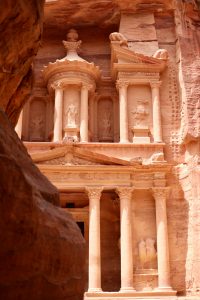Petra, Jordan: An Ancient Marvel
Historical Background: Petra, also known as the “Rose City” due to the color of the stone from which it is carved, is an ancient city that was the capital of the Nabataean Kingdom. The Nabataeans were an Arab tribe who established Petra as a major trading hub around the 6th century BC. Petra thrived as a center of commerce and culture until the Romans annexed it in 106 AD. It was later largely abandoned after a series of earthquakes and changing trade routes.
Architecture and Major Structures: Petra is renowned for its rock-cut architecture and advanced water conduit system. Here are some of the most notable structures within Petra:
-
Al-Khazneh (The Treasury):
- This is Petra’s most iconic structure, instantly recognizable for its stunning facade. Carved out of sandstone rock, it was originally a mausoleum and crypt. The Treasury gets its name from a legend that it contained hidden treasure.
-
The Monastery (Ad Deir):
- Similar in style to the Treasury but larger, the Monastery is another monumental building. It is accessible by climbing approximately 800 steps. The views from the Monastery are spectacular, overlooking the surrounding valleys.
-
The Siq:
- The Siq is the narrow gorge that serves as the main entrance to Petra. It is about 1.2 kilometers long and offers a dramatic approach to the city, with its towering cliffs and colorful rock formations.
-
The Royal Tombs:
- These are a series of large tombs with elaborate facades, including the Urn Tomb, the Silk Tomb, and the Corinthian Tomb. They demonstrate the Nabataeans’ architectural prowess and their affinity for grand burial places.
-
The Great Temple:
- This is one of the largest structures in Petra, believed to have been a significant place for public and religious gatherings. It includes a colonnaded courtyard, an audience hall, and numerous other buildings.
Cultural and Archaeological Significance: Petra is a UNESCO World Heritage Site and one of the New Seven Wonders of the World. Its significance lies not only in its architectural and engineering achievements but also in its role as a cultural melting pot. The city shows a blend of Nabataean, Roman, and Hellenistic influences, reflecting its history as a crossroads of civilizations.
Modern Discoveries and Tourism: In modern times, Petra was re-discovered by the Swiss explorer Johann Ludwig Burckhardt in 1812. Since then, it has become one of the most visited tourist attractions in the Middle East. Ongoing archaeological excavations continue to reveal more about the city’s history and the Nabataean civilization.
Visiting Petra: Tourists visiting Petra can explore the site on foot or with the help of donkeys, camels, or horse-drawn carriages. It’s advisable to spend at least two days in Petra to fully appreciate its vastness and grandeur. Key tips for visitors include wearing comfortable walking shoes, bringing plenty of water, and planning visits early in the morning or late in the afternoon to avoid the midday heat.
Cultural Experiences: Visitors can also enjoy a night-time experience known as “Petra by Night,” where the Siq and Treasury are lit by thousands of candles, creating a magical ambiance. Local Bedouin guides often share stories and traditional music, adding to the cultural richness of the visit.
In summary, Petra is not only a testament to the ingenuity and creativity of the Nabataeans but also a symbol of the region’s rich history and cultural diversity. Its breathtaking structures and intriguing history make it a must-visit destination for travelers and history enthusiasts alike.




